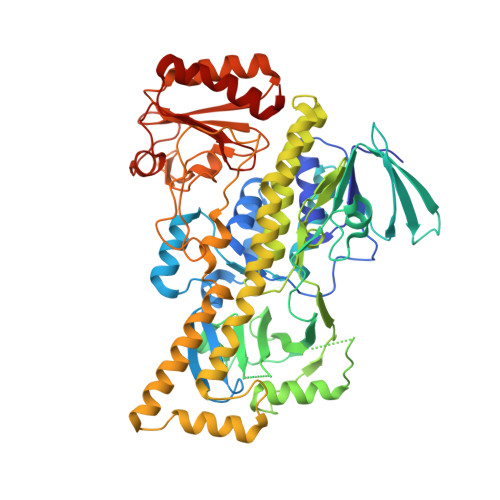A crystal structure of 2-hydroxybiphenyl 3-monooxygenase with bound substrate provides insights into the enzymatic mechanism.
Kanteev, M., Bregman-Cohen, A., Deri, B., Shahar, A., Adir, N., Fishman, A.(2015) Biochim Biophys Acta 1854: 1906-1913
- PubMed: 26275805
- DOI: https://doi.org/10.1016/j.bbapap.2015.08.002
- Primary Citation of Related Structures:
4Z2R, 4Z2T, 4Z2U, 5BRT - PubMed Abstract:
2-Hydroxybiphenyl 3-monooxygenase (HbpA) is an FAD dependent monooxygenase which catalyzes the ortho-hydroxylation of a broad range of 2-substituted phenols in the presence of NADH and molecular oxygen. We have determined the structure of HbpA from the soil bacterium Pseudomonas azelaica HBP1 with bound 2-hydroxybiphenyl, as well as several variants, at a resolution of 2.3-2.5Å to investigate structure function correlations of the enzyme. An observed hydrogen bond between 2-hydroxybiphenyl and His48 in the active site confirmed the previously suggested role of this residue in substrate deprotonation. The entrance to the active site was confirmed by generating variant G255F which exhibited only 7% of the wild-type's specific activity of product formation, suggesting inhibition of substrate entrance into the active site by the large aromatic residue. Residue Arg242 is suggested to facilitate FAD movement and reduction as was previously reported in studies on the homologous protein para-hydroxybenzoate hydroxylase. In addition, it is suggested that Trp225, which is located in the active site, facilitates proper substrate entrance into the binding pocket in contrast to aklavinone-11-hydroxylase and para-hydroxybenzoate hydroxylase in which a residue at a similar position is responsible for substrate deprotonation. Structure function correlations described in this work will aid in the design of variants with improved activity and altered selectivity for potential industrial applications.
- Department of Biotechnology and Food Engineering, Technion-Israel Institute of Technology, Haifa, Israel.
Organizational Affiliation:

















